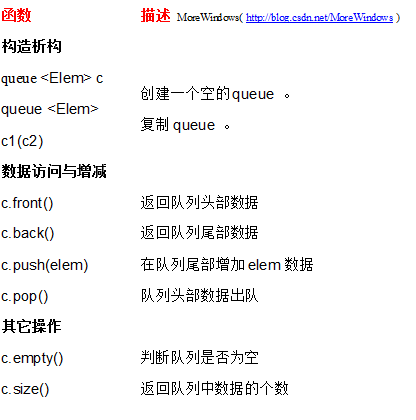STL之queue
2016-05-24 15:37
417 查看
queue单向队列与栈有点类似,一个是在同一端存取数据,另一个是在一端存入数据,另一端取出数据。单向队列中的数据是先进先出(First In First Out,FIFO)。在STL中,单向队列也是以别的容器作为底部结构,再将接口改变,使之符合单向队列的特性就可以了。因此实现也是非常方便的。下面就给出单向队列的函数列表和VS2008中单向队列的源代码。单向队列一共6个常用函数(front()、back()、push()、pop()、empty()、size()),与栈的常用函数较为相似。

VS2008中queue单向队列的源代码
友情提示:初次阅读时请注意其实现思想,不要在细节上浪费过多的时间。
[cpp] view
plain copy
<span style="font-size:18px;">//VS2008中 queue的定义 MoreWindows整理(http://blog.csdn.net/MoreWindows)
template<class _Ty, class _Container = deque<_Ty> >
class queue
{ // FIFO queue implemented with a container
public:
typedef _Container container_type;
typedef typename _Container::value_type value_type;
typedef typename _Container::size_type size_type;
typedef typename _Container::reference reference;
typedef typename _Container::const_reference const_reference;
queue() : c()
{ // construct with empty container
}
explicit queue(const _Container& _Cont) : c(_Cont)
{ // construct by copying specified container
}
bool empty() const
{ // test if queue is empty
return (c.empty());
}
size_type size() const
{ // return length of queue
return (c.size());
}
reference front()
{ // return first element of mutable queue
return (c.front());
}
const_reference front() const
{ // return first element of nonmutable queue
return (c.front());
}
reference back()
{ // return last element of mutable queue
return (c.back());
}
const_reference back() const
{ // return last element of nonmutable queue
return (c.back());
}
void push(const value_type& _Val)
{ // insert element at beginning
c.push_back(_Val);
}
void pop()
{ // erase element at end
c.pop_front();
}
const _Container& _Get_container() const
{ // get reference to container
return (c);
}
protected:
_Container c; // the underlying container
};</span>
可以看出,由于queue只是进一步封装别的数据结构,并提供自己的接口,所以代码非常简洁,如果不指定容器,默认是用deque来作为其底层数据结构的(对deque不是很了解?可以参阅《STL系列之一deque双向队列》)。下面给出单向队列的使用范例:
[cpp] view
plain copy
//单向队列 queue支持 empty() size() front() back() push() pop()
//By MoreWindows(http://blog.csdn.net/MoreWindows)
#include <queue>
#include <vector>
#include <list>
#include <cstdio>
using namespace std;
int main()
{
//可以使用list作为单向队列的容器,默认是使用deque的。
queue<int, list<int>> a;
queue<int> b;
int i;
//压入数据
for (i = 0; i < 10; i++)
{
a.push(i);
b.push(i);
}
//单向队列的大小
printf("%d %d\n", a.size(), b.size());
//队列头和队列尾
printf("%d %d\n", a.front(), a.back());
printf("%d %d\n", b.front(), b.back());
//取单向队列项数据并将数据移出单向队列
while (!a.empty())
{
printf("%d ", a.front());
a.pop();
}
putchar('\n');
while (!b.empty())
{
printf("%d ", b.front());
b.pop();
}
putchar('\n');
return 0;
}
转载请标明出处,原文地址:http://blog.csdn.net/morewindows/article/details/6950917

VS2008中queue单向队列的源代码
友情提示:初次阅读时请注意其实现思想,不要在细节上浪费过多的时间。
[cpp] view
plain copy
<span style="font-size:18px;">//VS2008中 queue的定义 MoreWindows整理(http://blog.csdn.net/MoreWindows)
template<class _Ty, class _Container = deque<_Ty> >
class queue
{ // FIFO queue implemented with a container
public:
typedef _Container container_type;
typedef typename _Container::value_type value_type;
typedef typename _Container::size_type size_type;
typedef typename _Container::reference reference;
typedef typename _Container::const_reference const_reference;
queue() : c()
{ // construct with empty container
}
explicit queue(const _Container& _Cont) : c(_Cont)
{ // construct by copying specified container
}
bool empty() const
{ // test if queue is empty
return (c.empty());
}
size_type size() const
{ // return length of queue
return (c.size());
}
reference front()
{ // return first element of mutable queue
return (c.front());
}
const_reference front() const
{ // return first element of nonmutable queue
return (c.front());
}
reference back()
{ // return last element of mutable queue
return (c.back());
}
const_reference back() const
{ // return last element of nonmutable queue
return (c.back());
}
void push(const value_type& _Val)
{ // insert element at beginning
c.push_back(_Val);
}
void pop()
{ // erase element at end
c.pop_front();
}
const _Container& _Get_container() const
{ // get reference to container
return (c);
}
protected:
_Container c; // the underlying container
};</span>
可以看出,由于queue只是进一步封装别的数据结构,并提供自己的接口,所以代码非常简洁,如果不指定容器,默认是用deque来作为其底层数据结构的(对deque不是很了解?可以参阅《STL系列之一deque双向队列》)。下面给出单向队列的使用范例:
[cpp] view
plain copy
//单向队列 queue支持 empty() size() front() back() push() pop()
//By MoreWindows(http://blog.csdn.net/MoreWindows)
#include <queue>
#include <vector>
#include <list>
#include <cstdio>
using namespace std;
int main()
{
//可以使用list作为单向队列的容器,默认是使用deque的。
queue<int, list<int>> a;
queue<int> b;
int i;
//压入数据
for (i = 0; i < 10; i++)
{
a.push(i);
b.push(i);
}
//单向队列的大小
printf("%d %d\n", a.size(), b.size());
//队列头和队列尾
printf("%d %d\n", a.front(), a.back());
printf("%d %d\n", b.front(), b.back());
//取单向队列项数据并将数据移出单向队列
while (!a.empty())
{
printf("%d ", a.front());
a.pop();
}
putchar('\n');
while (!b.empty())
{
printf("%d ", b.front());
b.pop();
}
putchar('\n');
return 0;
}
转载请标明出处,原文地址:http://blog.csdn.net/morewindows/article/details/6950917
相关文章推荐
- 使用C++实现JNI接口需要注意的事项
- 关于指针的一些事情
- c++ primer 第五版 笔记前言
- share_ptr的几个注意点
- Lua中调用C++函数示例
- Lua教程(一):在C++中嵌入Lua脚本
- Lua教程(二):C++和Lua相互传递数据示例
- C++联合体转换成C#结构的实现方法
- C++高级程序员成长之路
- C++编写简单的打靶游戏
- C++ 自定义控件的移植问题
- C++变位词问题分析
- C/C++数据对齐详细解析
- C++基于栈实现铁轨问题
- C++中引用的使用总结
- 使用Lua来扩展C++程序的方法
- C++中调用Lua函数实例
- Lua和C++的通信流程代码实例
- C与C++之间相互调用实例方法讲解
- 解析C++中派生的概念以及派生类成员的访问属性
